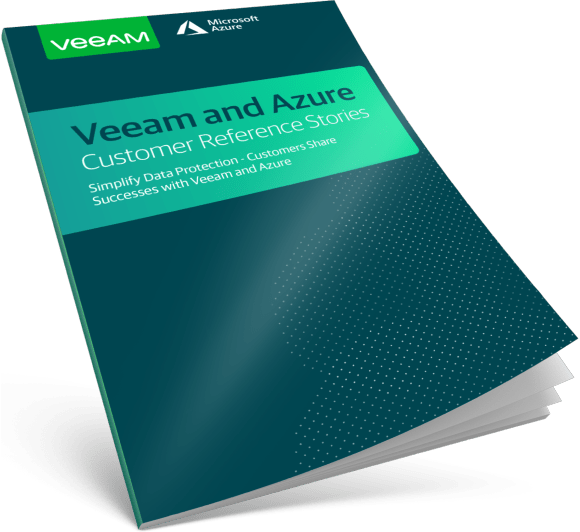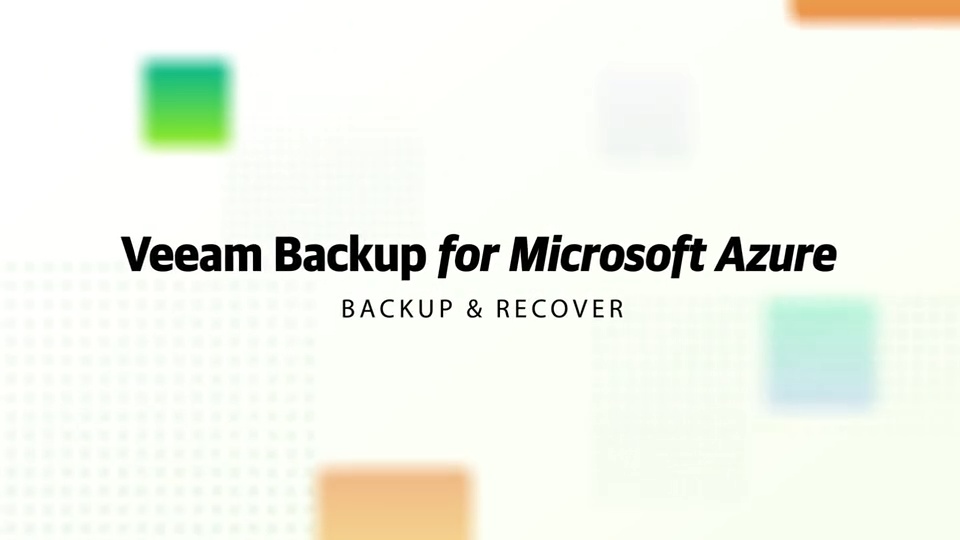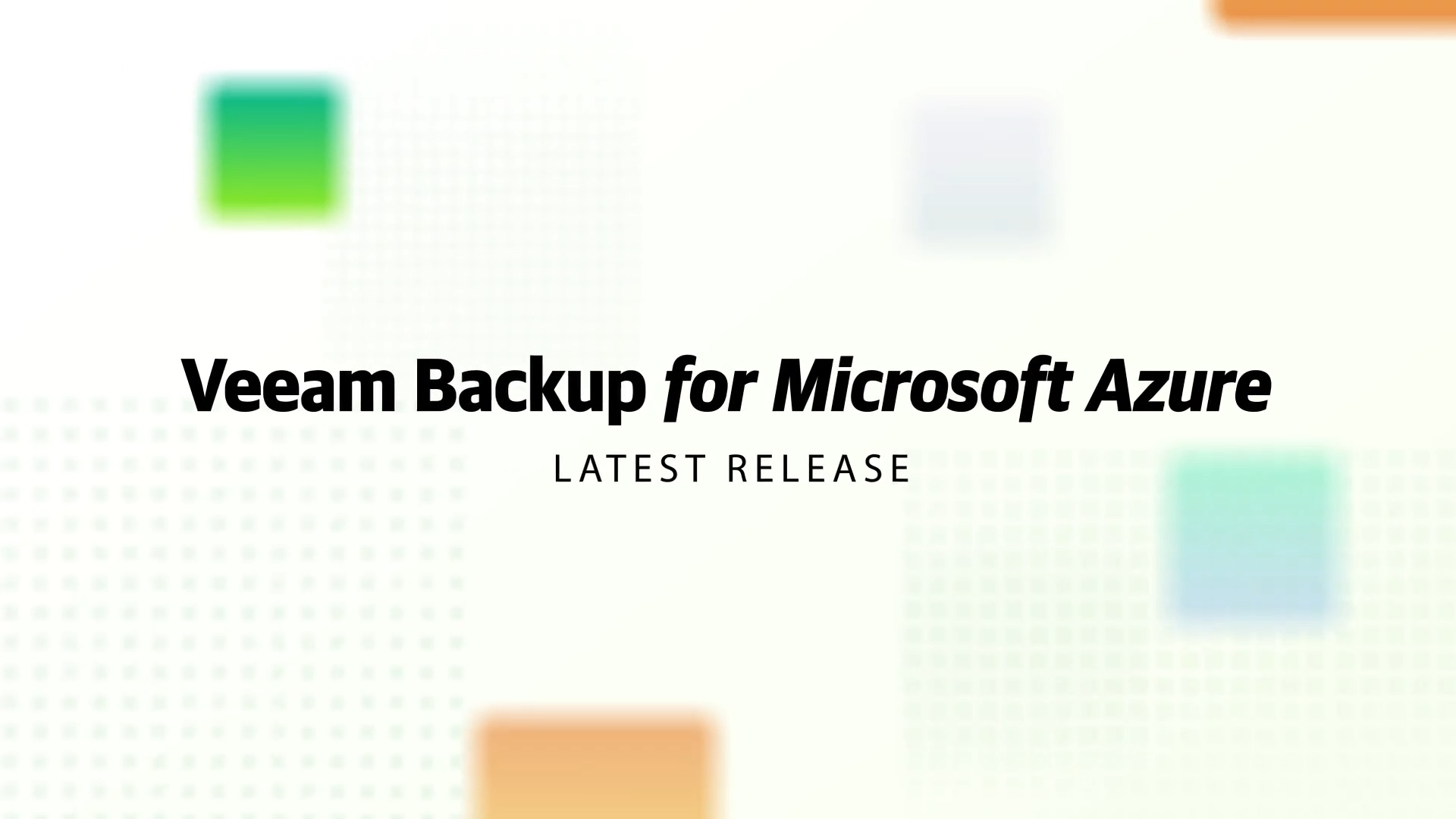BaaS for Microsoft 365 and Azure
#1 in Backup – Now as a Service
Now fully hosted, pre-configured backup is just a click away
- Veeam Data Platform
- Azure Backup & Recovery
Azure Backup & Recovery
For cloud resiliency and efficiency
- Goes beyond limited snapshots with agentless backup
- Secure backup with Immutable Storage for Azure Blob
- Fast, reliable recovery including file-level restore
- Azure Backup & Recovery
- Benefits
- Capabilities
- Latest Release
- How it Works
- Packaging Options
- Resources
Comprehensive, Automated Protection for Microsoft Azure Data
Layered Security
Including logical separation, least privilege access and immutability for cloud resiliency.
Powerful Recovery
Broad coverage of recovery options in and out of the cloud.
Optimized for Azure
The most customizable RPOs with comprehensive, native protection that keeps cloud costs down.
Veeam Backup for Microsoft Azure Key Features
Logically Air-Gapped
Logical separation of backup data from production accounts.
Secure Access
Least-privilege IAM and role-based access controls (RBAC).
Immutable Storage
Leverage Immutable Storage in Azure Blob to store data in a WORM state.
Recovery Flexibility
Across subscriptions, regions or even restore outside of Azure.*
Full- and File-Level
Full instance or granular recovery, either in place or as new.
Simplified Recovery
Wizard-driven, automated and self-service workflows.
Automated Backup
Automated discovery and protection via native backups.
Cost-Optimized
Backup lifecycling to object storage with cost calculations.
Hybrid Ready
Operationally consistent management across hybrid- and multi-cloud* environments.
Level up cloud resiliency and recovery efficiency
Azure Blob Backup
Azure Virtual Network Backup
Granular Azure Account Permissions
How Veeam Protects Microsoft Azure Data
Supported Services in Veeam Backup for Microsoft Azure
Veeam Data Platform
Veeam Backup for Microsoft Azure is available as a virtual machine (VM) offer exclusively through the Azure Marketplace in both Free and BYOL editions.
per instance, per year
- In-cloud backup and recovery
- Per instance licensing
- 24.7.365 production support
- Centralized management
- Data and license portability
- 24.7.365 production support
| Veeam Backup for Microsoft Azure |
Veeam Backup & Replication |
|
| A standalone solution to back up and recover Azure workloads within Azure only | #1 backup and recovery for unified hybrid-/multi-cloud data protection and management | |
| Azure backup and recovery | ||
| Cost control | ||
| Security and compliance | ||
| Unlimited data portability | ||
| Hybrid-/multi-cloud management |
Unify Azure Backup and Recovery With Other Workloads
Veeam Backup & Replication
Centrally manage Azure backups with other cloud, virtual, physical, SaaS and Kubernetes environments.
Baas for Azure Data
END USERS
Need help with Azure backup?
Our global network of service providers deliver Veeam-powered BaaS offerings for your Azure data. Now you can leave your data protection duties to the experts and get back to focusing on your business (or take an extra-long lunch — we won’t judge!)
SERVICE PROVIDERS
Are you a service provider looking to add Azure BaaS?
With Veeam, you gain a true partner in helping you build a revenue-generating, Veeam-powered Azure BaaS offering for your customers. To get started, join the Veeam Cloud & Service Provider (VCSP) program. It’s free! Unlock exclusive products, pricing and partner perks designed to aid your services business.
Veeam and Microsoft Azure
Essilior Amera
Mishcon de Reya LLP
HBC
Stay Up to Date With Azure Trends

Veeam and Azure Customer Reference Book
Learn how Veeam and Microsoft Azure protect your critical data and applications.
Veeam and Azure Solution Brief
Learn how your business can transform its data protection strategy.
Conversational Azure Backup Best Practices
10 Azure backup best practices, directly from two Microsoft MVPs!
Documentation
Additional Resources
FAQs
How do I back up Azure cloud?
Based on Microsoft’s Shared Responsibility Model, it’s the user’s responsibility to plan and implement a backup and recovery strategy for their Azure data. There are native services in place that allow you to back up Azure VMs, Azure SQL and Azure Files, and there are many vendors that offer agent-based approaches for both Azure backups and on-premises workloads. However, data protection in the cloud isn't always straightforward, so leveraging limited or legacy backup methods can present some challenges.
First, Azure VM snapshots are not real backups, and therefore cannot be leveraged for long-term data retention and recovery. Aged snapshots are also costly when they’re kept in Azure for longer than a few days. Manual scripting to automate native Azure VM snapshots can also quickly become complex, especially in large environments.
Secondly, an agent-based approach for Azure backup is not the best option either, since agents require resource-intensive deployment, are hard to scale appropriately and take up additional VM space.
Whenever you use a cloud-native backup solution like Veeam Backup for Microsoft Azure, an image-based backup is created automatically from native Azure VM snapshots that are based on your chosen backup policy. This allows for greater control and management of your daily data protection operations and policy deployments, as well as improved application-aware processing and quicker recovery for Azure VMs.
How does Azure backup work?
For more details, watch this short video here.
In short, Veeam Backup for Microsoft Azure can automatically create and manage snapshots and backups of Azure VMs (including managed or unmanaged VHDs) along with VM configuration. Backup chains can be created with image-level backups or snapshots. Image-level backups can include full and incremental backups, and cloud-native snapshots include point-in-time snapshots. Recovery can be performed at the full- or file-level in just seconds.
- With Veeam Backup for Microsoft Azure, you can protect data on your Azure VMs either through snapshots or backups, all with purpose-built, cloud-native tools. Combining both snapshots and backups gives you the flexibility to choose the best option to protect your Azure data, whether that be a specific file, a few test VMs or large production environments. Snapshots are great for testing and upgrading if you need to roll back quickly to a certain point in time. However, for longer retention and proper recovery purposes, backups are the way to go for protecting Azure data. Backup files will be stored in Microsoft Azure Blob, meaning you can choose a cool storage option at a lower cost.
- Whenever we create a backup file that’s based on Azure VM snapshots or perform a recovery from an image-based backup file, Veeam Backup for Microsoft Azure deploys temporary instances, called workers. These are deployed to Azure accounts only when you need to create a backup from a snapshot or a restore.
- You can either create specific configurations for each Azure region that you want to deploy workers in, or you can let Veeam can do this automatically. This means you don’t have to set them up for each and every region!
- Once an image-based backup file for Azure VMs is created, you can choose to store it either in hot or cool storage tiers, depending on your data retention policy.
- You have multiple policy options to choose from. You can define which Azure accounts you want to back up in each region, and you can choose whether you want to back up separate Azure VMs or use a tag-based policy so you don’t have to manually add each new VM to your backup policy.
- Choose from multiple schedule options for both Azure snapshots (down to 60 snapshots per hour) and backups to satisfy even the most stringent SLAs. You can also define how long you’d like to keep snapshots and backups of your Azure data.
- Scheduling options also allow you to specify where you’d like to keep your Azure snapshots or backups. You can also choose from hot and cool storage options with Azure Blob. Veeam recommends that you use the cool storage tier option for Azure backup files, since it significantly lowers the storage costs.
- Veeam Backup for Microsoft Azure has a built-in calculation tool that will automatically estimate the cost of your configurated backup policy for Azure data. These calculations are provided up-front when you configure your Azure backup policy and are broken down to the monthly cost of your Azure Blob storage. This includes charges for traffic to move between regions and even estimates for moving backup data in and out of Azure Blob storage.
- Finally, you can choose from multiple restore options for your backed-up Azure data. You can quickly restore an entire Azure VM, virtual disk or specific individual files, and, like in the Azure backup process, workers will be deployed and attached to a specific point-in-time. Then you’ll get a URL within the Veeam Backup for Microsoft Azure interface that you can use to browse for the exact data you want to restore.
All in all, the journey from Azure Marketplace to connecting a Veeam Backup for Microsoft Azure appliance to your account and setting up the backup policy takes no more than 15 minutes!
Why do I need to back up Azure cloud data?
Microsoft does not keep backups of your data. Per their Shared Responsibility Model, it is still your responsibility to ensure that your data is secured and protected, whether it is IaaS, PaaS or SaaS that’s being consumed.
The backup and recovery of data in Azure remains the responsibility of the end user, according to the Microsoft Shared Responsibility Model. Without backup and recovery, your applications and/or data cannot be restored to overcome data loss due to accidental deletion, cybersecurity threats, ransomware, outage, etc. Veeam delivers enterprise-grade Azure backup and recovery that’s cost-effective and secure, so you’re protected against any cloud data loss.
What backup types are available for Azure backup?
For more details, check out the documentation for Veeam Backup for Microsoft Azure.
Veeam Backup for Microsoft Azure allows you to create image-level backup chains from native Azure VM snapshots.
Both full and incremental backup files will be included into the following chains:
- Full: A full backup file with a copy of the full Azure VM image.
- Incremental: Incremental backup files that keep record of incremental changes of Azure VM images.
We leverage the incremental backup method to create a backup chain for Azure VMs. This means that during the first backup session, a full backup file will be created in a backup repository from a copied Azure VM image. This will serve as a starting point for the backup chain, and Veeam Backup for Microsoft Azure will copy only the data blocks that have changed.
Both full and incremental backup files will serve as restore points for your Azure backups, and you can easily roll back to whatever point-in-time you choose.
Radical Resilience Starts Here
hybrid cloud and the confidence you need for long-term success.






